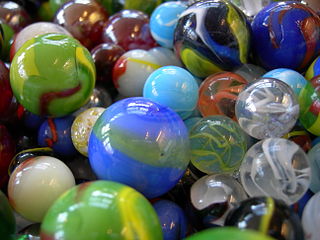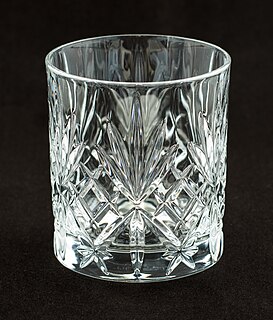Related Research Articles

Glass is a non-crystalline, often transparent amorphous solid, that has widespread practical, technological, and decorative use in, for example, window panes, tableware, and optics. Glass is most often formed by rapid cooling (quenching) of the molten form; some glasses such as volcanic glass are naturally occurring. The most familiar, and historically the oldest, types of manufactured glass are "silicate glasses" based on the chemical compound silica, the primary constituent of sand. Soda-lime glass, containing around 70% silica, accounts for around 90% of manufactured glass. The term glass, in popular usage, is often used to refer only to this type of material, although silica-free glasses often have desirable properties for applications in modern communications technology. Some objects, such as drinking glasses and eyeglasses, are so commonly made of silicate-based glass that they are simply called by the name of the material.

A dip pen or nib pen or pen nib usually consists of a metal nib with capillary channels like those of fountain pen nibs, mounted in a handle or holder, often made of wood. Other materials can be used for the holder, including bone, metal and plastic; some pens are made entirely of glass.

Cameo is a method of carving an object such as an engraved gem, item of jewellery or vessel. It nearly always features a raised (positive) relief image; contrast with intaglio, which has a negative image. Originally, and still in discussing historical work, cameo only referred to works where the relief image was of a contrasting colour to the background; this was achieved by carefully carving a piece of material with a flat plane where two contrasting colours met, removing all the first colour except for the image to leave a contrasting background.

Pyrex is a brand introduced by Corning Inc. in 1915 for a line of clear, low-thermal-expansion borosilicate glass used for laboratory glassware and kitchenware. It was later expanded to include ware products made of soda-lime glass and other materials.

A marble is a small spherical object often made from glass, clay, steel, plastic, or agate. These balls vary in size. Most commonly, they are about 13 mm in diameter, but they may range from less than 1 mm to over 8 cm (3 in), while some art glass marbles for display purposes are over 30 cm (12 in) wide. Marbles can be used for a variety of games called marbles. They are often collected, both for nostalgia and for their aesthetic colors. In the North of England the objects and the game are called "taws", with larger taws being called "bottle washers" after the use of a marble in Codd-neck bottles, which were often collected for play. These toys can be used to make marble runs, a form of art, or they can be used in marble races.

Seed beads or rocailles are uniformly shaped, spheroidal beads ranging in size from under a millimeter to several millimeters. Seed bead is also a generic term for any small bead. Usually rounded in shape, seed beads are most commonly used for loom and off-loom bead weaving. They may be used for simple stringing, or as spacers between other beads in jewelry.

Cloisonné is an ancient technique for decorating metalwork objects with colored material held in place or separated by metal strips or wire, normally of gold. In recent centuries, vitreous enamel has been used, but inlays of cut gemstones, glass and other materials were also used during older periods; indeed cloisonné enamel very probably began as an easier imitation of cloisonné work using gems. The resulting objects can also be called cloisonné. The decoration is formed by first adding compartments to the metal object by soldering or affixing silver or gold as wires or thin strips placed on their edges. These remain visible in the finished piece, separating the different compartments of the enamel or inlays, which are often of several colors. Cloisonné enamel objects are worked on with enamel powder made into a paste, which then needs to be fired in a kiln. If gemstones or colored glass are used, the pieces need to be cut or ground into the shape of each cloison.

Ariadne auf Naxos, Op. 60, is a 1912 opera by Richard Strauss with a German libretto by Hugo von Hofmannsthal. The opera's unusual combination of elements of low commedia dell'arte with those of high opera seria points up one of the work's principal themes: the competition between high and low art for the public's attention.

Pressed glass is a form of glass made by pressing molten glass into a mold using a plunger. It was first patented by American inventor John P. Bakewell in 1825 to make knobs for furniture.

A paperweight is a small solid object heavy enough, when placed on top of papers, to keep them from blowing away in a breeze or from moving under the strokes of a painting brush. While any object can serve as a paperweight, decorative paperweights of glass are produced, either by individual artisans or factories, usually in limited editions, and are collected as works of fine glass art, some of which are exhibited in museums. First produced in about 1845, particularly in France, such decorative paperweights declined in popularity before undergoing a revival in the mid-twentieth century.

The old fashioned glass, rocks glass, lowball glass is a short tumbler used for serving spirits, such as whisky, neat or with ice cubes. It is also normally used to serve certain cocktails, such as the old fashioned, from which it receives its name. The true old fashioned glass is decorated in the cut glass style, although most modern examples are pressed glass, made using a mold. The design is essentially English, from the late 18th or 19th-century. Plain glass versions are lowball glasses.

Chance Brothers and Company was a glassworks originally based in Spon Lane, Smethwick, West Midlands, in England. It was a leading glass manufacturer and a pioneer of British glassmaking technology.
The Fostoria Glass Company was a manufacturer of pressed, blown and hand-molded glassware and tableware. It began operations in Fostoria, Ohio, on December 15, 1887, on land donated by the townspeople. The new company was formed by men from West Virginia who were experienced in the glassmaking business. They started their company in northwest Ohio to take advantage of newly discovered natural gas that was an ideal fuel for glassmaking. Numerous other businesses were also started in the area, and collectively they depleted the natural gas supply. Fuel shortages caused the company to move to Moundsville, West Virginia in 1891.

Pauly & C. - Compagnia Venezia Murano is one of the most ancient glass factory of Murano: it was founded more than 150 years ago. This company produces glass art, most notably Roman murrine, mosaics and chandeliers.

An engraved gem, frequently referred to as an intaglio, is a small and usually semi-precious gemstone that has been carved, in the Western tradition normally with images or inscriptions only on one face. The engraving of gemstones was a major luxury art form in the Ancient world, and an important one in some later periods.

A lemon drop is a vodka-based cocktail that has a lemony, sweet and sour flavor, prepared using lemon juice, triple sec and simple syrup. It has been described as a variant of, or as "a take on", the Vodka Martini, but is in actual fact a closer to a White Lady variant. It is typically prepared and served straight up – chilled with ice and strained.
Mark Hill is a British antiques expert, TV presenter, author and publisher.
J. H. Hobbs, Brockunier and Company was one of the largest and best known manufacturers of glass in the United States in the 19th century. Its products were distributed world-wide. The company is responsible for one of the greatest innovations in American glassmaking—an improved formula for lime glass that enabled American glass makers to produce high-quality glass at a lower cost. The firm also developed many of the talented glassmakers that started glass factories in Ohio and Indiana.

John George Sowerby (1849–1914) was an English painter and illustrator from Gateshead, and director of Ellison Glass Works, the Sowerby family business, which during the 1880s was the largest producer of pressed glass in the world. The grandson of naturalist James Sowerby, his paintings were exhibited in the Royal Academy of Arts, and his children's book illustrations were generally well received.
References
- ↑ Ray Shill (2005), Birmingham and the Black Country's canal industries, Tempus, p. 66, ISBN 978-0-7524-3262-5
- 1 2 3 Mallalieu, Huon; Corbett, Sue; Edwards, Graeme, eds. (1994), Antiques Roadshow A - Z of Antiques Hunting, Peter Jackson (Editorial director), Jeremy Wallington (Publishing Director), Headwater Communications Referenced from the monthly collectible journal; later published as a book, ISBN 978-0-7522-1092-6
- ↑ Gordon Campbell (2006), The Grove encyclopedia of decorative arts, vol. 2, Oxford University Press US, p. 188, ISBN 978-0-19-518948-3 , retrieved 6 September 2009